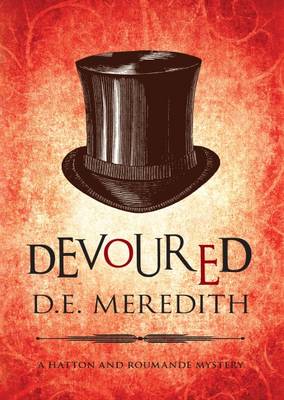
EURO CRIME
Reviews

Meredith, D E - 'Devoured'
Hardback: 352 pages (Aug. 2012) Publisher: Allison & Busby ISBN: 0749012757
It is 1856 and London is gripped by a huge collecting obsession. Men of science are journeying to far off countries and jungles, collecting examples of botanical types, skeletons and all manner of specimens that will in future years prove to be the foundation of the collections in the museums off the Brompton Road in South Kensington and Knightsbridge, London.
The murdered body of Lady Bessingham is discovered,in the main bedroom of her house on Nightingale Walk, Chelsea surrounded by her vast collection of fossils and tribal masks. Inspector George Adams of Scotland Yard asks Professor Adolphus Hatton of St Barts Hospital along to the murder scene, as he had recently published a series of articles in the Lancet explaining the new science of forensics and Adams hopes that it will enable him to locate the murderer faster.
Professor Hatton has an French assistant named Monsieur Albert Roumande, who seems to do more of the actual work of pathology including the cutting up of the bodies than does Hatton, who appears to want to add his sleuthing skills to the those of Inspector Adams, when he isn't engaged elsewhere. Between the chapters describing the work of Hatton et al, are chapters quoting letters from the scientist Benjamin Broderig addressed to Lady Bessingham. They describe his travels in Sarawak, Borneo and the interaction he has with his fellow travellers and the strange animals, insects, natives and other specimens he describes. They reminded me of the 'Professor Challenger' stories of Sir Arthur Conan Doyle and give a good sense of place to the story.
The science of forensic pathology was in its infancy at that time of course and the investigatory techniques were very primitive in comparison to what we know today but it is very interesting how much the pathologists of that time were able to discover with what limited evidence they had to hand and the primitive conditions they had to work in.
A number of other murders occur which are all apparently connected to the events described in the letters from the explorer scientist Broderig. Professor Hatton has a number of other interesting adventures along the way, before the exciting denouement is reached in this remarkable, slow-burning historic thriller. The atmospheric and deftly plotted characters are all richly drawn and the details of this book are fascinating.
D E Meredith gives a very vivid picture of life at this time and I was transported by the wonderfully evocative story telling right back to Victorian London. The book in its hardback edition has sumptuous packaging including, very unusually, a ribbon page marker (I wish that all publishers followed this example) and a printed hardback case. All in all, a delightful and most extraordinary first novel in a new historic mystery series about the Victorian forensic pathologists Hatton and Roumande; the second novel, THE DEVIL'S RIBBON, is due out in the UK in February 2013 and I look forward to reading it.
Terry Halligan, England
November 2012
More European crime fiction reviews can be found on the Reviews page.